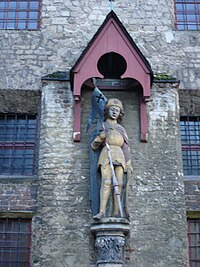Viktor of Xanten
This article needs additional citations for verification. (December 2022) |
Saint Viktor of Xanten | |
|---|---|
 Statue of Saint Victor outside Xanten Cathedral | |
| Died | 4th century |
| Venerated in | Roman Catholic Church, Eastern Orthodox Church |
| Major shrine | Xanten Cathedral |
| Feast | October 10 |
| Attributes | Military attire |
Viktor of Xanten was a 4th century martyr and saint recognized by the Roman Catholic Church and the Eastern Orthodox Church. Since the 12th century, his presumed bones have been kept in a shrine, which is embedded in the high altar of the Xanten Cathedral. His feast day is October 10.
Narrative
Tradition states that Viktor, as a Praefectus cohortis of a Cohort of the Theban Legion, was not caught up in the decimation at Agaunum but then fell victim to the persecution under Emperor Maximian together with other companions in Xanten.[1] He was executed in the amphitheater of Castra Vetera (the site of present-day Xanten) for refusing to sacrifice to the Roman gods. He was closely associated with Ursus of Solothurn, and is said to have been a relative of Saint Verena.
Victor was first mentioned by Gregory of Tours in connection with the discovery of the bones of a Mallosus in the village of Birten, today a suburb of Xanten.[2] The place name "Xanten" is also derived as "ze santen", which thus refers to a widely known and revered burial place.[1] According to legend, Helena of Constantinople recovered the bones of Victor and his legion and erected a chapel in their honour.
According to other traditions, he was a companion of Gereon of Cologne. The tradition of Victor as a member of the Theban Legion is mixed with that of Victor of Agaunum and Victor of Solothurn.[1]
References
Sources
- Ekkart Sauser (2003). "Victor von Xanten: hl. Märtyrer". In Bautz, Traugott (ed.). Biographisch-Bibliographisches Kirchenlexikon (BBKL) (in German). Vol. 21. Nordhausen: Bautz. col. 1511. ISBN 3-88309-110-3.
- (in Dutch) H.Victor van Xanten, martelaar
- Articles needing additional references from December 2022
- All articles needing additional references
- CS1 German-language sources (de)
- Articles with Dutch-language sources (nl)
- Articles with VIAF identifiers
- Articles with GND identifiers
- 4th-century Christian martyrs
- 4th-century deaths
- Saints from Roman Egypt
- Saints of Germania
- Year of birth unknown
- People from Xanten
- All stub articles
- Saint stubs
- Eastern Orthodoxy stubs